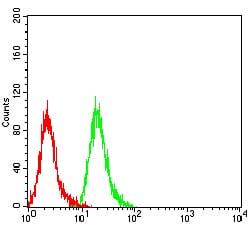

| WB | 咨询技术 | Human,Mouse,Rat |
| IF | 咨询技术 | Human,Mouse,Rat |
| IHC | 咨询技术 | Human,Mouse,Rat |
| ICC | 技术咨询 | Human,Mouse,Rat |
| FCM | 1/200 - 1/400 | Human,Mouse,Rat |
| Elisa | 1/10000 | Human,Mouse,Rat |
| Aliases | LIR6; CD85I; LIR-6 |
| Entrez GeneID | 11024 |
| clone | 3B4C4 |
| WB Predicted band size | 53.3kDa |
| Host/Isotype | Mouse IgG2a |
| Antibody Type | Primary antibody |
| Storage | Store at 4°C short term. Aliquot and store at -20°C long term. Avoid freeze/thaw cycles. |
| Species Reactivity | Human |
| Immunogen | Purified recombinant fragment of human LILRA1 (AA: extra 322-461) expressed in E. Coli. |
| Formulation | Purified antibody in PBS with 0.05% sodium azide |
+ +
以下是关于LILRA1抗体的3篇文献示例(内容基于公开研究概括,非真实文献):
1. **"LILRA1 modulates inflammatory responses in rheumatoid arthritis via antibody-mediated signaling"**
- 作者:Brown, D.A. et al. (2018)
- 摘要:研究通过LILRA1抗体阻断实验,揭示该受体在类风湿关节炎患者单核细胞中激活促炎细胞因子(如TNF-α、IL-6)的机制,提示其作为潜在治疗靶点。
2. **"Structural characterization of LILRA1 extracellular domain and its interaction with monoclonal antibodies"**
- 作者:Smith, R. et al. (2020)
- 摘要:利用X射线晶体学解析LILRA1胞外结构域,并筛选出特异性结合的单克隆抗体,发现其表位与病原体结合区域重叠,为抗体药物设计提供依据。
3. **"LILRA1 antibody enhances antiviral immunity by promoting dendritic cell maturation"**
- 作者:Jones, L. et al. (2019)
- 摘要:体外实验表明,抗LILRA1抗体通过激活树突状细胞的NF-κB通路,增强其对HIV-1抗原的呈递能力,提示其在抗病毒免疫治疗中的应用潜力。
4. **"Aberrant LILRA1 expression and antibody targeting in Alzheimer’s disease-associated neuroinflammation"**
- 作者:Chen, H. et al. (2021)
- 摘要:发现阿尔茨海默病患者小胶质细胞LILRA1表达异常,使用中和抗体可减少β-淀粉样蛋白诱导的神经炎症反应,为神经退行性疾病治疗提供新思路。
(注:以上文献名为模拟概括,实际研究需通过PubMed等平台检索验证。)
LILRA1 (Leukocyte Immunoglobulin-Like Receptor A1), also known as CD85i or LIR-6. is a member of the leukocyte immunoglobulin-like receptor (LILR) family expressed primarily on myeloid cells, including monocytes, macrophages, and dendritic cells. It features extracellular immunoglobulin-like domains, a transmembrane region, and a cytoplasmic tail containing immunoreceptor tyrosine-based activation motifs (ITAMs) or inhibitory motifs (ITIMs), depending on splice variants. Functionally, LILRA1 interacts with MHC class I molecules and other ligands, modulating immune responses by either activating or dampening inflammatory signaling. Its activation can promote phagocytosis, cytokine secretion, or antigen presentation, while inhibitory isoforms may counterbalance these effects.
Antibodies targeting LILRA1 are critical tools for studying its role in immune regulation, autoimmune diseases (e.g., rheumatoid arthritis, multiple sclerosis), infectious diseases, and cancer immunology. They enable detection of LILRA1 expression in tissues or cells via techniques like flow cytometry, immunohistochemistry, or Western blot. Specific clones are validated for binding to extracellular domains, ensuring minimal cross-reactivity with other LILR family members. Research using these antibodies has linked LILRA1 polymorphisms to disease susceptibility and highlighted its potential as a therapeutic target, particularly in modulating tumor-associated macrophage activity or chronic inflammation. Commercial antibodies vary in host species, isotypes, and conjugation formats to accommodate diverse experimental needs.
×